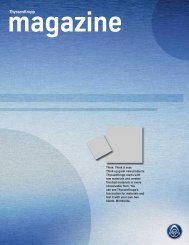Engineering
Engineering
Engineering
You also want an ePaper? Increase the reach of your titles
YUMPU automatically turns print PDFs into web optimized ePapers that Google loves.
3.6 Consolidated financial statements Notes to the consolidated financial statements<br />
Where an impairment loss subsequently reverses, the carrying amount<br />
of the asset (Cash Generating Unit) is increased to the revised estimate<br />
of its recoverable amount. The revised amount cannot exceed the<br />
carrying amount that would have been determined had no impairment<br />
loss been recognized for the asset (Cash Generating Unit) in prior<br />
years. A reversal of an impairment loss is recognized as income<br />
immediately. However, impairment losses of goodwill may not be<br />
reversed.<br />
Leases<br />
Leases are classified as either finance or operating. Lease transactions<br />
whereby the Group is the lessee and bears substantially all the risks<br />
and rewards incidental to ownership of an asset are accounted for as a<br />
finance lease. Accordingly, the Group capitalizes the leased asset at<br />
the lower of the fair value or the present value of the minimum lease<br />
payments and subsequently depreciates the leased asset over the<br />
shorter of the lease term and its useful life. In addition, the Group<br />
records a corresponding lease obligation on the balance sheet which is<br />
subsequently settled and carried forward using the effective interest<br />
method. All other lease agreements entered into by the Group, as a<br />
lessee, are accounted for as operating leases whereby the lease<br />
payments are expensed on a straight-line basis.<br />
Lease transactions whereby the Group is the lessor and transfers<br />
substantially all of the benefits and risks incident to the ownership of<br />
property, are accounted for as a sale and financing of the leased asset.<br />
The Group recognizes a receivable at an amount equal to the net<br />
investment in the lease and includes interest income in the<br />
consolidated income statement. All other lease agreements entered<br />
into by the Group, as a lessor, are accounted for as operating leases<br />
whereby the leased asset remains on the Group’s balance sheet and is<br />
depreciated. Scheduled lease payments are recognized in income on a<br />
straight-line basis over the lease term.<br />
Inventories<br />
Inventories are stated at the lower of acquisition/manufacturing cost or<br />
net realizable value. Net realizable value is the estimated selling price<br />
in the ordinary course of business less estimated costs of completion<br />
and selling costs. In general, inventories are valued using the average<br />
cost method. Manufacturing cost includes direct material, labor and<br />
allocable material and manufacturing overhead based on normal<br />
operating capacity.<br />
Consolidated financial statements<br />
136 | 137<br />
Financial instruments<br />
A financial instrument is any contract that at the same time gives rise<br />
to a financial asset of one entity and a financial liability or equity<br />
instrument of another entity. Financial instruments are recognized as<br />
soon as ThyssenKrupp becomes a contracting party to the financial<br />
instrument. In cases where trade date and settlement date do not<br />
coincide, the settlement date is used for initial recognition or<br />
derecognition. Financial instruments stated as financial assets or<br />
financial liabilities are generally not offset; they are only offset when a<br />
legal right to set-off exists at that time and settlement on a net basis is<br />
intended.<br />
Determining fair value<br />
The fair value of financial instruments is generally equal to the amount<br />
the Group would receive or pay if it exchanged or settled the financial<br />
instruments on the balance sheet date. If available, quoted market<br />
prices are used for financial instruments, especially for those<br />
categorized as available-for-sale financial assets. Otherwise, fair<br />
values are calculated based on the market conditions prevailing on the<br />
balance sheet date – interest rates, exchange rates, commodity prices<br />
– using middle rates or prices. In doing so, fair values are calculated<br />
using common methods, such as the option pricing models for<br />
currency and interest rate options or the discounted cash flow method<br />
for interest rate swaps. The fair values of some derivatives are based<br />
on external valuations by our financial partners.<br />
Financial assets<br />
In particular, financial assets include trade accounts receivable, cash<br />
and cash equivalents, derivative financial assets, as well as equity<br />
instruments and bonds held. Financial assets are initially recognized at<br />
fair value. This includes any transaction costs directly attributable to<br />
the acquisition of financial assets, which are not carried at fair value<br />
through profit or loss in future periods. The fair values recognized on<br />
the balance sheet usually reflect the market prices of the financial<br />
assets.<br />
Trade accounts receivable and other current receivables<br />
Receivables are accounted for at amortized cost less valuation<br />
allowances.

















